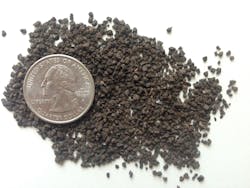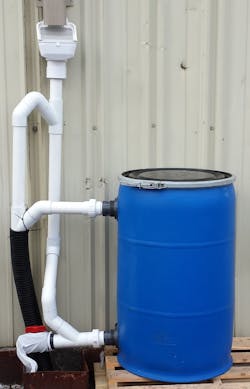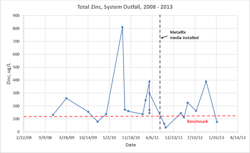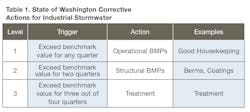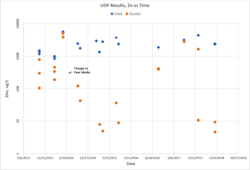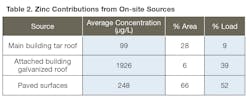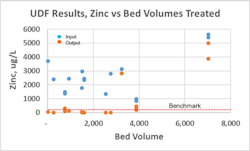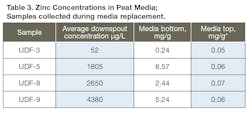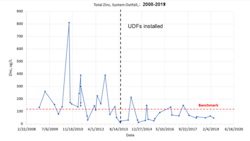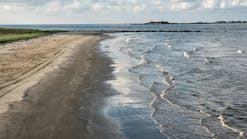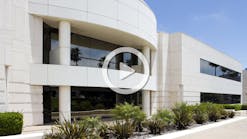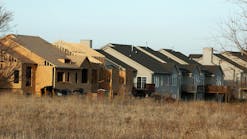The Washington State Department of Ecology requires a general stormwater permit for industrial facilities that discharge stormwater to waters of the state. Facilities in western Washington are required to monitor stormwater to ensure that benchmark values for pH (5–9), turbidity (less than 25 nephelometric turbidity units), visible oil sheen (none), and the trace metals copper (less than 14 micrograms per liter [µg/L]) and zinc (less than 117 µg/L) are being met.
If the concentrations in the stormwater exceed the benchmarks, a tiered response is triggered and the facility must institute, alter and/or improve its operational and/or structural practices to reduce concentrations in the stormwater discharge (Table 1). If changes in structural or operational practices do not reduce concentrations below benchmark values, treatment is required.A 15.4-acre industrial facility in western Washington has had a stormwater permit for a single outfall since the stormwater program began in 2004. The drainage basin is 100% impervious and includes 5.4 acres of building surface area. The main building is 4.4 acres with a torch-down tar material roof and a 1-acre extension with a factory-painted galvanized metal roof. The remaining portions of the facility are paved to accommodate vehicle traffic and include a large vehicle parking area and an outdoor material storage area.
Operational and structural best management practices were not successful in reducing metal concentrations to below benchmark values, so an end-of-pipe (EOP) treatment system was installed in 2008. This system included a lift pump station, a Vortechs solids removal unit, and a StormFilter stormwater filtration system. The StormFilter unit was designed to treat the design flow rate of 720 gallons per minute (GPM) through media-filled cartridges. The cartridges originally contained zeolite, perlite, and granular-activated carbon (ZPG).After the treatment system was installed, zinc concentrations continued to exceed benchmark values (Figure 3). Despite additional operational and structural measures, concentrations continued to exceed benchmarks so, in 2011, the treatment media was changed to Metal RX in the hope of achieving higher metal removal.
Metal removal improved initially but effluent concentrations increased in 2012 and the site was once again out of compliance, having exceeded the benchmark for three consecutive quarters (Figure 3).
The ApproachThe company decided to determine the sources of zinc in the watershed so they could better target future mitigation efforts. The site was divided into three main sub-basins: the main building roof, the attached metal building roof, and the remainder of the basin (i.e., the paved areas). The zinc concentrations for each sub-basin were either measured or calculated and the total mass load from each area was estimated. Although the paved area contributed slightly over 50% of the total load, the attached 1-acre galvanized roof, which was only 6% of the total area, contributed almost 40% of the total mass load of zinc (Table 2). The galvanizing process coats the roof with a layer of zinc to preserve the underlying metal roof by providing a protective coating. The zinc oxidizes preferentially to iron and extends the lifetime of the roof. Although this is effective, zinc is released and is washed off the roof when it rains.
To address the paved area source, the company, which had been contracting for sweeping services, purchased their own sweeper and increased the amount of weekly sweeping from two to eight hours.
Three options were considered to reduce the load from the galvanized roof: replacing the roof, painting the roof, or treating the elevated zinc concentrations in the roof runoff.
The most cost-effective approach appeared to be treating the water coming off the roof. Commercial systems were available to capture and treat the flow from the downspouts but cost between $30–40,000. It was decided to conduct a pilot study using a fabricated downspout treatment unit made from an inexpensive 55-gallon barrel. If successful, these could be installed for about $8,000, which was less than a third of the cost of the least expensive commercial units. The units were designed so that the water from the downspout would flow up through the media and were, therefore, called an upflow drum filter or UDF.
UDFs were made from 55-gallon drums with an inlet at the bottom (Figure 1). Water entered through a 3-inch diameter, 4-foot long diffuser coiled at the base of the drum, which was surrounded by an 8-inch layer of 5/8 inch clean drain rock. A commercially available filter fabric separated the drain rock from about 1 cubic foot of adsorptive media mixture. The media was covered with another layer of filter fabric, which was then covered with a 4-inch layer of drain rock.
A 0.955 mm stainless steel screen was placed at the front end of the system where water from the downspout enters the pipe that feeds into the bottom of the drum. This is used to minimize clogging in the diffuser system from coarse debris coming off the roof. A backflush valve at the base of the unit allows the system to be purged to remove any fine-grained accumulated solids in the diffuser system. The flushed solids are collected in a filter sock for disposal.
Based on the design flow for the site, each UDF can treat about 0.1 acres of roof.
Pilot StudyAn initial pilot study was conducted between March 20 and April 19, 2013, to analyze the performance of the UDF with two different media combinations. The two media combinations tested were zeolite alone and a 2:1 mixture of compost and zeolite. The UDFs were successful in reducing the zinc concentrations; the compost/zeolite removed about 70%, while the zeolite alone removed about 50%.Full-scale implementation began in September 2013 with UDFs being installed on all nine downspouts. In 2014, the compost/zeolite media was changed to a peat sorption media (APTsorb) due to better metal removal and flow characteristics (Figure 2). This media is a hardened granulated peat product produced by American Peat Technology and has been effective in removing both suspended and dissolved metals from industrial stormwater and mining discharges (Eger et al., 2016, 2017). The particle size is 0.6 to 2 mm and the media has a hydraulic conductivity around 1 cm/sec. Metal removal capacities measured in laboratory equilibrium tests have ranged from 1 to 15% dry weight metal.
Results and Discussion
Since the permit only required regular monitoring of the treated effluent from the site, only periodic samples of the UDF inlet and outlet were collected (Figure 4). Zinc was generally removed in all samples, but lower concentrations were observed after the peat media was installed, and often the UDF effluent zinc concentrations were lower than the benchmark values.
All sorption media has a finite lifetime since there are a fixed number of removal sites on the media. The treatment lifetime is a function of the number of removal sites, the input concentration, the flow volume, and the desired effluent concentration which is often the permitted limit. In order to ensure continuous treatment, sorption media needs to be replaced periodically.
Lifetimes are often expressed in terms of bed volumes, which is a unitless measure of the amount of water that can be treated by a fixed volume of media. The bed volume of the system is the volume of reactive media, or in this case the volume of peat sorption media in the UDF. The lifetime of the media is defined as Bed Volumes = Total volume treated / Volume of media.It can also be thought of as the total gallons of water that can be treated by a single gallon of media.
When the data for the peat media is plotted against bed volumes, zinc is removed in all samples, but treatment appears to decrease after around 3000-bed volumes (Figure 5). The 6-month rainfall at the site is equivalent to around 4000-bed volumes, which was chosen as the replacement interval based on observation of overall system performance.During one of the replacements, samples of the media were collected and zinc concentrations were measured at the bottom and top of the UDF (Table 3). Zinc concentrations at the bottom (inlet) varied among sites and were generally related to the input concentration. However, the zinc concentrations near the top of all the UDFs were much lower and generally equivalent to the concentration in the unreacted media. This suggests that there was still removal capacity in the media, and it might be possible to increase the time between replacements.
Since the peat media is a light, hardened granular media, it can easily be removed by a Vactor truck, which simplifies maintenance. To change the media in all nine units takes only about a day. Zinc is not one of the eight heavy metals listed and monitored by the Resource Recovery and Conservation Act (RCRA) but, in general, removed metals are tightly bound to the peat and the media passes toxicity characteristic leaching procedure (TCLP) requirements, which greatly simplifies disposal (Eger et al, 2017).After the UDFs were installed, concentrations in the EOP treatment system effluent decreased. Although some individual samples have exceeded the benchmark, there has never been any consecutive exceedances so that the site is now in compliance with its permit.
Conclusions
UDFs were successful in removing zinc from galvanized metal roof runoff at an industrial facility. By employing a 6-month maintenance cycle for the UDFs, the zinc load to the EOP treatment system was reduced, the effluent was generally below the benchmark value and the site is in compliance. The UDFs cost less than a third of the least expensive commercial units and are simple to maintain.
References
Eger, P., Jones, P., Green, D., Poplawski, T., Wagner, J. 2017. “Removing Trace Metals from Stormwater at an Industrial Hard Chrome Plating Facility.” Stormwater, September 2017, 38–43.
Eger, P., Jones, P., and Green, D. 2016. “Solving mine drainage water issues with peat-based sorption media.” Mining Engineering, 2016, Vol. 68, No. 2, 38–43.
Tobiason S, Duffner B, Moldver A, Mueller S. 2006. “Roof runoff as a zinc source: BMP effectiveness at Seattle-Tacoma International Airport.” StormCon 2006.
Paul Eger
Paul Eger is an environmental engineer with Global Minerals Engineering LLC in Hibbing, MN.
Chad Wiggins
Chad Wiggins is an environmental engineer with Catchment Solutions LLC in Seattle, WA.
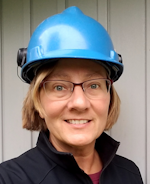
Peggy Jones
Peggy Jones is vice president of sales and research for American Peat Technology in Aitkin, MN.
Doug Green
Doug Green is the CEO of American Peat Technology in Aitkin, MN.
